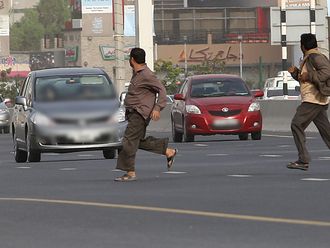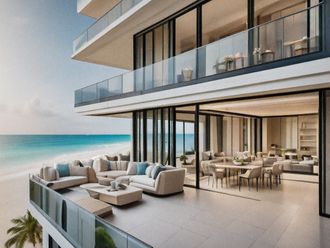The Command and Control Centre (C3), Al Qusais, is where 999 calls are taken and screened and where the police keep tabs on accidents and crimes.
The centrepiece is a 14-by-4-metre screen, divided into 40 squares, each monitoring six cameras. It coordinates the work of patrol cars, boats, mounted police, motorbikes and ambulances under the police wing.
Above it is a line that displays the number of emergency calls in progress. Below is a line that displays breaking news from around the world.
With 6,000 distress calls received daily – the number is increasing due to the rise in the city's inhabitants – Dubai Police uses the latest high-tech gear and is ready to tackle any disaster, said Col. Kamal Butti Al Suwaidi, Deputy Director of the General Department of Command and Control.
The operations centre is one of the first in the Middle East to use a 3D city model, he added.
Each of the police's 120 patrol cars is also equipped with a 3D map of the city and Global Positioning System (GPS) which gives their exact location at any given time and real-time access to the centres.
“The 3D images enable us to better visualise the location and status of incidents,'' said Al Suwaidi. “The need to protect citizens and residents from criminals and bad guys increases with the rise in population.''
While he declined to give figures on the total cost of the set-up, the centre monitors 1,200 cameras around the city. This number is expected to increase when monitors for the new freehold communities – such as The Gardens, Dubai Marina, The Palm, Business Bay – are wired into the system.
Moreover, the centre allows the police to simulate incidents for training. The centre conducts regular drills simulating scenarios including terror attacks.
“In the unfortunate event that a disaster strikes, the centre can be quickly reconfigured to create an independent disaster response unit,'' Al Suwaidi said. This frees up the regular centre to handle routine tasks.
Omar Abdullah Al Shamsi, Director of C3, said that any call should be handled in two minutes at the most. At any given time, 30 police officers are on hand to take emergency calls.
There is also a separate emergency unit to connect callers to hospitals as part of the unified Emergency Medical Service which Dubai unveiled last year.
“At the end of the day, our job is to stay awake so our citizens and residents can sleep soundly,'' said Al Suwaidi.
When you cal 999
You will be connected directly to the Dubai Police Command and Control Centre. Two call centres operate simultaneously, manned by 30 call takers. Each call-taker monitors two screens.
The first has a digital map, updated via satellite that allows him to zoom in on the location of the caller. The second is a database screen that allows him to file details of the caller and his/her complaint.
If the call-taker finds it difficult to communicate with the caller, he is automatically transferred to a person who speaks the language of the caller.Languages spoken include Arabic, English, German, Russian, Chinese, Urdu and Persian.
The information goes to the dispatcher. Every dispatcher sits in front of three screens. One screen contains street details in Dubai, another contains details of the complaint and the third identifies the police patrol nearest the incident.The patrol then checks the location of the incident, pinpointing it on an onboard map and follows it up.















